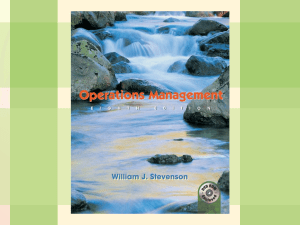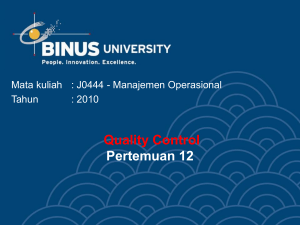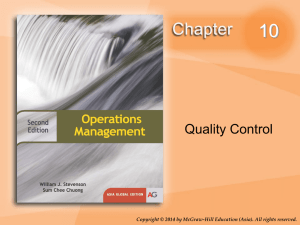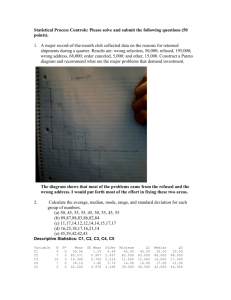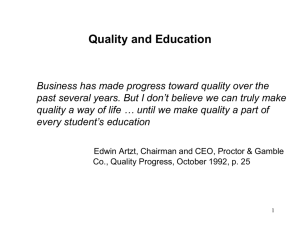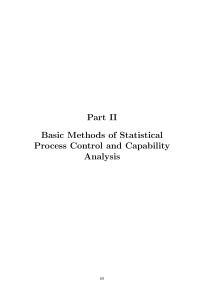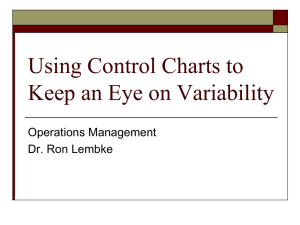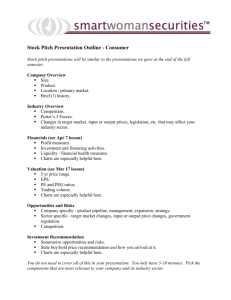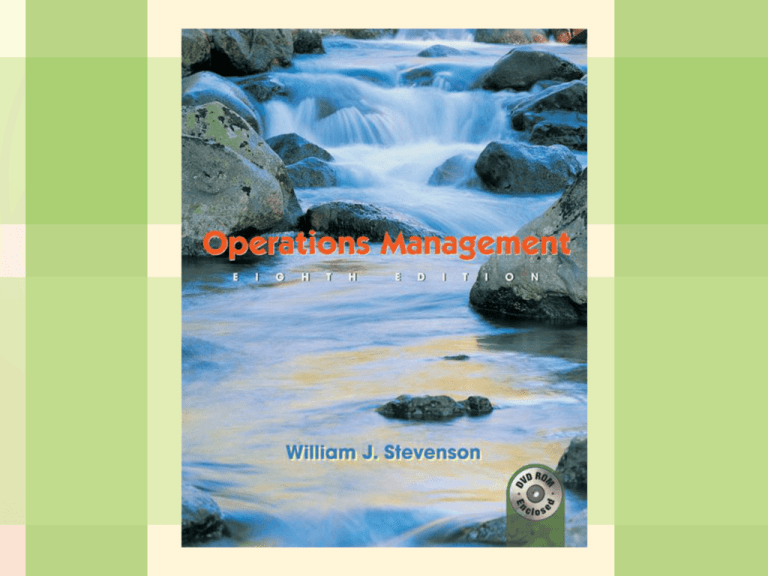
10-1
Quality Control
Operations Management
William J. Stevenson
8th edition
10-2
Quality Control
CHAPTER
10
Quality Control
McGraw-Hill/Irwin
Operations Management, Eighth Edition, by William J. Stevenson
Copyright © 2005 by The McGraw-Hill Companies, Inc. All rights reserved.
10-3
Quality Control
Phases of Quality Assurance
Figure 10.1
Inspection
before/after
production
Acceptance
sampling
The least
progressive
Inspection and
corrective
action during
production
Process
control
Quality built
into the
process
Continuous
improvement
The most
progressive
10-4
Quality Control
Inspection
Figure 10.2
How Much/How Often
Where/When
Centralized vs. On-site
Inputs
Acceptance
sampling
Transformation
Process
control
Outputs
Acceptance
sampling
10-5
Quality Control
Inspection Costs
Cost
Figure 10.3
Total Cost
Cost of
inspection
Cost of
passing
defectives
Optimal
Amount of Inspection
10-6
Quality Control
Where to Inspect in the Process
Raw materials and purchased parts
Finished products
Before a costly operation
Before an irreversible process
Before a covering process
10-7
Quality Control
Examples of Inspection Points
Table 10.1
Type of
business
Fast Food
Inspection
points
Cashier
Counter area
Eating area
Building
Kitchen
Hotel/motel Parking lot
Accounting
Building
Main desk
Supermarket Cashiers
Deliveries
Characteristics
Accuracy
Appearance, productivity
Cleanliness
Appearance
Health regulations
Safe, well lighted
Accuracy, timeliness
Appearance, safety
Waiting times
Accuracy, courtesy
Quality, quantity
10-8
Quality Control
Statistical Process Control:
Statistical evaluation of the output of a process
during production
Quality of Conformance:
A product or service conforms to
specifications
10-9
Quality Control
Control Chart
Control Chart
Purpose: to monitor process output to see if
it is random
A time ordered plot representative sample
statistics obtained from an on going process
(e.g. sample means)
Upper and lower control limits define the
range of acceptable variation
10-10
Quality Control
Control Chart
Figure 10.4
Abnormal variation
due to assignable sources
Out of
control
UCL
Mean
Normal variation
due to chance
LCL
Abnormal variation
due to assignable sources
0
1
2
3
4
5
6
7
8
9
Sample number
10 11 12 13 14 15
10-11
Quality Control
Statistical Process Control
The essence of statistical process control is
to assure that the output of a process is
random so that future output will be random.
10-12
Quality Control
Statistical Process Control
The Control Process
Define
Measure
Compare
Evaluate
Correct
Monitor results
10-13
Quality Control
Statistical Process Control
Variations and Control
Random variation: Natural variations in the
output of a process, created by countless
minor factors
Assignable variation: A variation whose
source can be identified
10-14
Quality Control
Sampling Distribution
Figure 10.5
Sampling
distribution
Process
distribution
Mean
10-15
Quality Control
Normal Distribution
Figure 10.6
Standard deviation
Mean
95.44%
99.74%
10-16
Quality Control
Control Limits
Figure 10.7
Sampling
distribution
Process
distribution
Mean
Lower
control
limit
Upper
control
limit
10-17
Quality Control
Type I error
SPC Errors
Concluding a process is not in control when
it actually is.
Type II error
Concluding a process is in control when it
is not.
10-18
Quality Control
Type I Error
Figure 10.8
/2
/2
Mean
Probability
of Type I error
LCL
UCL
10-19
Quality Control
Observations from Sample Distribution
Figure 10.9
UCL
LCL
1
2
Sample number
3
4
10-20
Quality Control
Control Charts for Variables
Variables generate data that are measured.
Mean control charts
Used to monitor the central tendency of a
process.
X bar charts
Range control charts
Used to monitor the process dispersion
R charts
10-21
Quality Control
Mean and Range Charts
Figure 10.10A
(process mean is
shifting upward)
Sampling
Distribution
UCL
Detects shift
x-Chart
LCL
UCL
R-chart
LCL
Does not
detect shift
10-22
Quality Control
Mean and Range Charts
Figure 10.10B
Sampling
Distribution
(process variability is increasing)
UCL
x-Chart
LCL
Does not
reveal increase
UCL
R-chart
Reveals increase
LCL
10-23
Quality Control
Control Chart for Attributes
p-Chart - Control chart used to monitor the
proportion of defectives in a process
c-Chart - Control chart used to monitor the
number of defects per unit
Attributes generate data that are counted.
10-24
Quality Control
Use of p-Charts
Table 10.3
When observations can be placed into two
categories.
Good or bad
Pass or fail
Operate or don’t operate
When the data consists of multiple samples
of several observations each
10-25
Quality Control
Use of c-Charts
Table 10.3
Use only when the number of occurrences per
unit of measure can be counted; nonoccurrences cannot be counted.
Scratches, chips, dents, or errors per item
Cracks or faults per unit of distance
Breaks or Tears per unit of area
Bacteria or pollutants per unit of volume
Calls, complaints, failures per unit of time
10-26
Quality Control
Use of Control Charts
At what point in the process to use control
charts
What size samples to take
What type of control chart to use
Variables
Attributes
10-27
Quality Control
Run Tests
Run test – a test for randomness
Any sort of pattern in the data would suggest
a non-random process
All points are within the control limits - the
process may not be random
10-28
Quality Control
Nonrandom Patterns in Control charts
Figure 10.11
Trend
Cycles
Bias
Mean shift
Too much dispersion
10-29
Quality Control
Figure 10.12
Counting Runs
Counting Above/Below Median Runs
B A
Figure 10.13
A
B
A
B
B
B A
Counting Up/Down Runs
U
U
D
U
(7 runs)
A
B
(8 runs)
D
U
D U
U D
10-30
Quality Control
Tolerances or specifications
Range of acceptable values established by
engineering design or customer requirements
Process variability
Process Capability
Natural variability in a process
Process capability
Process variability relative to specification
10-31
Quality Control
Process Capability
Figure 10.15
Lower
Specification
Upper
Specification
A. Process variability
matches specifications
Lower
Specification
Upper
Specification
B. Process variability
Lower
Upper
well within specifications Specification Specification
C. Process variability
exceeds specifications
10-32
Quality Control
Process Capability Ratio
specification width
Process capability ratio, Cp =
process width
Cp =
Upper specification – lower specification
6
10-33
Quality Control
3 Sigma and 6 Sigma Quality
Upper
specification
Lower
specification
1350 ppm
1350 ppm
1.7 ppm
1.7 ppm
Process
mean
+/- 3 Sigma
+/- 6 Sigma
10-34
Quality Control
Improving Process Capability
Simplify
Standardize
Mistake-proof
Upgrade equipment
Automate
10-35
Quality Control
Taguchi Loss Function
Figure 10.17
Traditional
cost function
Cost
Taguchi
cost function
Lower
spec
Target
Upper
spec
10-36
Quality Control
Limitations of Capability Indexes
1.
Process may not be stable
2.
Process output may not be normally
distributed
3.
Process not centered but Cp is used
10-37
Quality Control
CHAPTER
10
Additional PowerPoint slides
contributed by
Geoff Willis,
University of Central Oklahoma.
10-38
Quality Control
Statistical Process Control (SPC)
Invented by Walter Shewhart at Western
Electric
Distinguishes between
common cause variability (random)
special cause variability (assignable)
Based on repeated samples from a process
10-39
Quality Control
Empirical Rule
-3 -2
-1
+1 +2 +3
68%
95%
99.7%
10-40
Quality Control
Control Charts in General
Are named according to the statistics being
plotted, i.e., X bar, R, p, and c
Have a center line that is the overall average
Have limits above and below the center line
at ± 3 standard deviations (usually)
Upper Control Limit (UCL)
Center line
Lower Control Limit (LCL)
10-41
Quality Control
Variables Data Charts
Process Centering
n
X bar chart
X bar is a sample mean
X
X
i 1
i
n
Process Dispersion (consistency)
R chart
R is a sample range
R max( X i ) min( X i )
10-42
Quality Control
X bar charts
Center line is the grand mean (X double bar)
m
Points are X bars
x / n
UCL X z x
X
LCL X z x
-OR-
UCL X A2 R
LCL X A2 R
X
j 1
m
j
10-43
Quality Control
R Charts
Center line is the grand mean (R bar)
Points are R
D3 and D4 values are tabled according to n
(sample size)
UCL D4 R
LCL D3 R
10-44
Quality Control
Use of X bar & R charts
Charts are always used in tandem
Data are collected (20-25 samples)
Sample statistics are computed
All data are plotted on the 2 charts
Charts are examined for randomness
If random, then limits are used “forever”
10-45
Quality Control
Attribute Charts
c charts – used to count defects in a constant
sample size
UCL c z c
n
c
c
i 1
m
centerline
LCL c z c
10-46
Quality Control
Attribute Charts
p charts – used to track a
proportion (fraction)
defective
m
p
p
j 1
m
p(1 p)
UCL p z
n
n
pi
x
ij
nm
x
i 1
i
n
centerline
p(1 p)
LCL p z
n
10-47
Quality Control
Process Capability
The ratio of process variability to design specifications
Text
-3σ
Text
Text
-2σ -1σ
Text
Title
µ
Text
Natural data
Text
spread
+1σ +2σ +3σ
Lower
Upper
Spec
Spec
The natural spread
of the data is 6σ
10-48
Quality Control
Training
MQ4
Job rotation/quality fatigue at Honda
10-49
Quality Control
Quality Measurement
STA10
Monitoring
10-50
Quality Control
Services/Measurement
STAO3
Survey/Efficiency, Admission/Discharge

